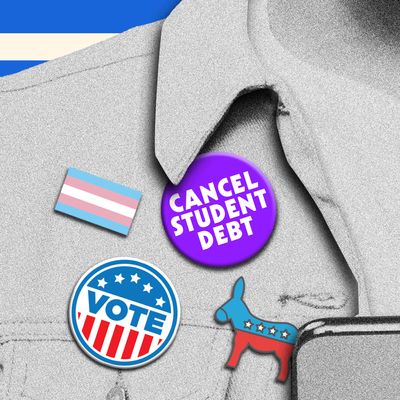
A lot of what Joe Biden has been doing lately seems a bit strange for a president whose party is struggling toward the midterms in the shadow of an inflation panic that just won’t go away. Yes, he helped seal a Manchin-Schumer deal on an “Inflation Reduction Act” that Republicans have gleefully mocked as just more runaway Democrat spending. But he’s also issued a controversial student-loan forgiveness initiative, and now a blanket pardon for people convicted on federal marijuana possession charges. Neither of those policies are about inflation.
What they are about (aside from highlighting issues other than inflation) is an effort to boost youth turnout in the midterm elections. As Ron Brownstein points out in The Atlantic, under-30 voters are the largest segment of voters that leans Democratic reliably, but that also participates in midterm elections unreliably:
Compared with older generations, Millennials and members of Generation Z are more racially diverse, more likely to hold postsecondary degrees, and less likely to identify with any religious tradition. Both cohorts have leaned sharply Democratic since the first Millennials entered the electorate in large numbers in the 2004 election; the party has routinely carried about three-fifths of young adults in recent presidential contests. In 2018, Democrats hit a peak of support among young voters, winning two-thirds of those younger than 30 and three-fifths of those ages 30 to 44, according to estimates by Catalist, a Democratic targeting firm. …
For Democrats, this year’s nightmare scenario of losing both the House and Senate is a repeat of 2010 and 2014, when the GOP midterm sweeps were turbocharged by a catastrophic falloff in turnout among young people from the presidential race two years earlier.
The good news for Democrats is that in the last midterms in 2018, there wasn’t any major drop in youth turnout, which had a lot to do with Democratic success in that cycle. The bad news is that President Biden — certainly no favorite of young voters in the 2020 presidential primaries — is not terribly popular in this segment of the electorate. Indeed, the gap between Democratic voting inclinations and job approval for Biden among millennial and Gen-Z voters is one of the central puzzles of the midterms: If young voters are unhappy with the Democratic president but still dislike Republicans, will they just stay home, as their counterparts did in 2010 and 2014?
Obviously Democrats want to keep that from happening, but it’s not 100 percent clear that young voters’ disdain for Uncle Joe is a problem they can solve. Part of his unpopularity is intergenerational: Young voters experience the same economic problems (especially the cost of living) as their elders even more acutely. But another factor is disappointment among progressive youth at Democratic accomplishments since Biden was elected, particularly on issues affecting them most. And that’s what both the president and his congressional allies are clearly trying to address, as Brownstein observes:
[L]ifting Democratic hopes is the party’s summer succession of policy advances on issues important to young people. [Pollster John] Della Volpe said the “No. 1” criticism of Biden among young adults in the Harvard poll was “ineffectiveness.” But the passage of the Inflation Reduction Act, with its sweeping provisions to combat climate change, and the president’s decision to cancel up to $20,000 in student debt for millions of borrowers have provided Democratic organizers and ad makers something they lacked earlier this year: evidence to argue to young adults that their votes did produce change on things they care about. Biden gave organizers another talking point yesterday afternoon, when he announced a sweeping pardon of all people convicted of simple marijuana possession under federal law.
It’s also worth noting that younger voters are more strongly in favor of abortion rights than other age cohorts, and are most personally threatened by Republican plans for state and federal abortion bans. That’s particularly true of young women, as Amelia Thomson-DeVeaux recently explained at FiveThirtyEight:
Sixty-four percent of 18- to 29-year-old women say they’re following news about abortion laws and restrictions very or somewhat closely — more than the share who say they’re closely following news about gas prices and inflation (55 percent) or the 2022 midterm elections (25 percent). Young women are also much likelier than Americans as a whole to say that abortion is a critical issue for them personally, by 61 percent to 36 percent.
There’s also a lot of evidence that young women are at the heart of the post-Dobbs boom in voter registration by women. And more generally, youth turnout may be easier to stimulate because of registration gains during the last two high-youth-engagement election cycles. To put it simply, it’s easier to get registered voters to exercise their voting rights than it is to get them registered and turn them out, particularly for less experienced voters.
As with so many factors in this midterm election, a lot could change between now and November 8. But we should soon begin gathering some evidence from early voting about the likely shape of the electorate. If youth turnout rates more closely resemble those of 2018 or 2020 than of 2010 or 2014, Democratic odds will improve. And it’s not just a matter of success or failure in 2022. The long-term viability of the Democratic Party depends a lot on building a durable following among millennial and Gen-Z voters. Uncle Joe may need them more in 2024 than he does right now.
More on the 2022 midterms
- Are Democrats the Party of Low-Turnout Elections Now?
- New Midterms Data Reveals Good News for Democrats in 2024
- The Return of the Emerging Democratic Majority?






























